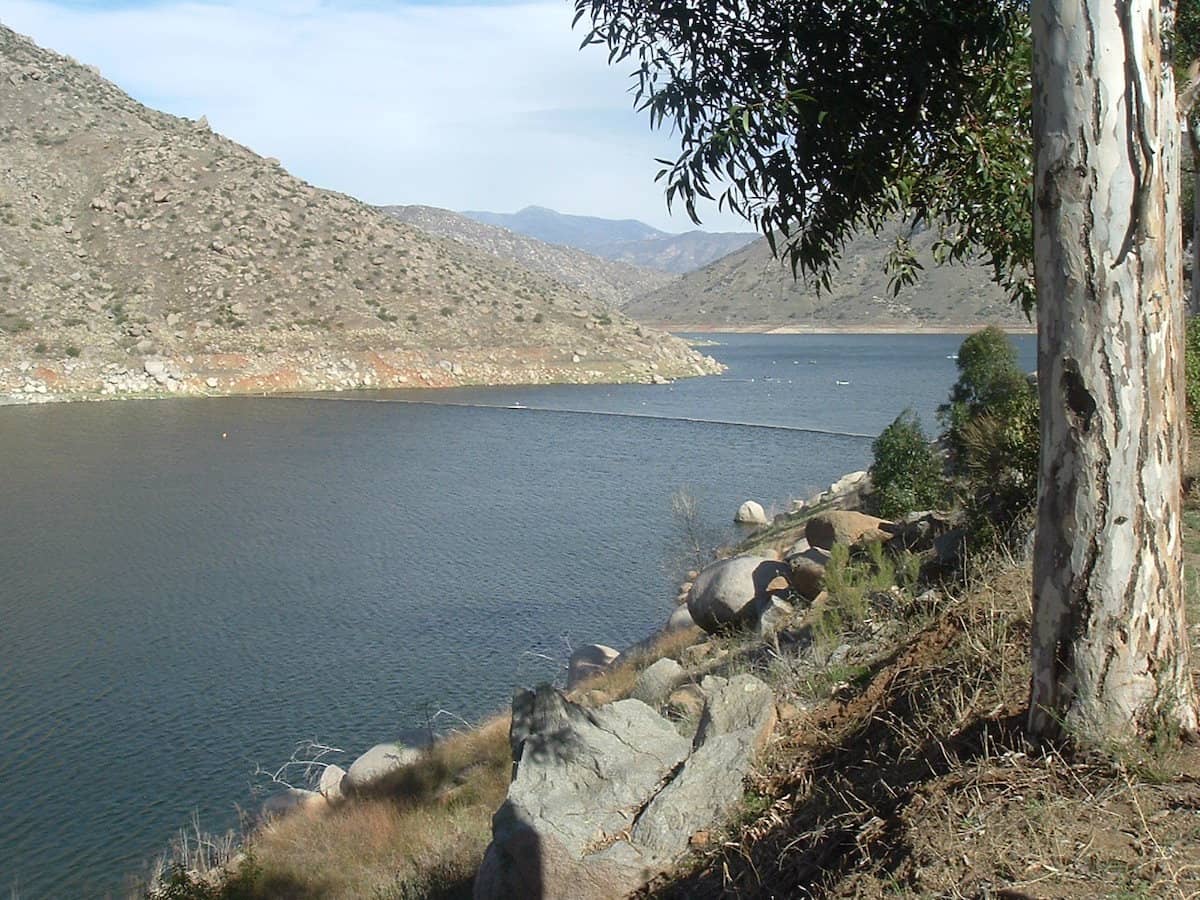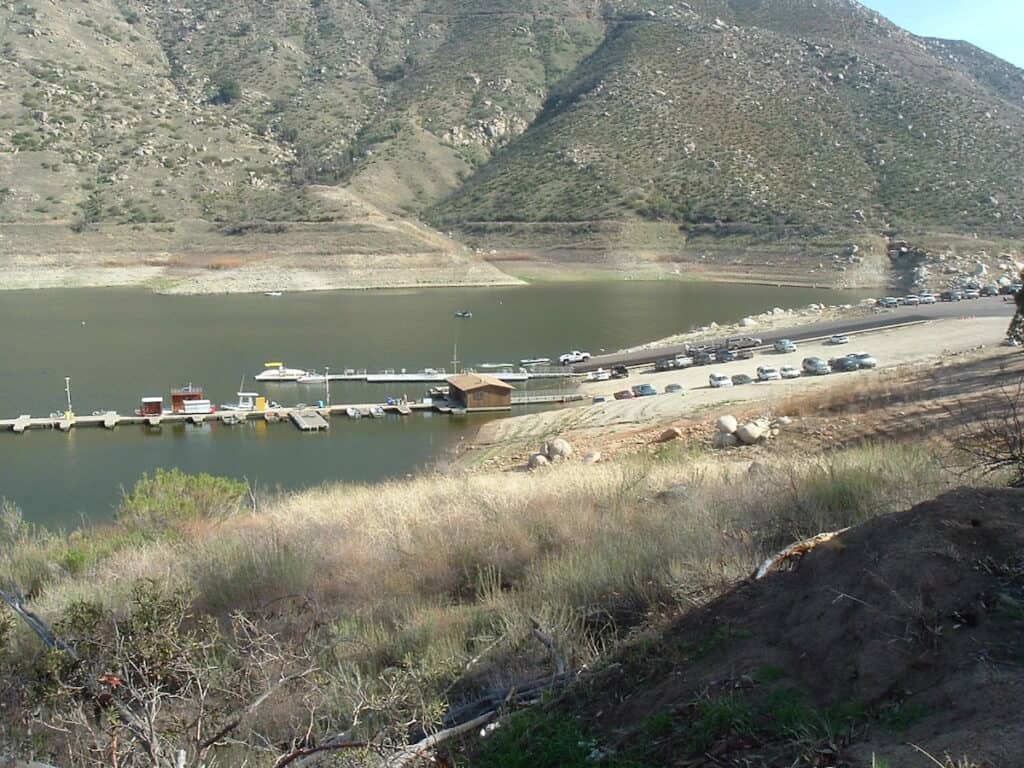One of the largest of San Diego’s city-owned lakes, El Capitan Reservoir is known as one of the best largemouth bass fishing lakes anywhere in Southern California.
And if you’re more interested in fish for dinner than landing a trophy-worthy bass, the reservoir also is an excellent place to catch a mess of crappie and catfish.
Unlike some of the area’s lakes, hatchery trout are not generally stocked at El Capitan, but no matter because something is just about always biting in this climate.
Located 30 miles northeast of the city of San Diego, “El Cap” is easily reached and offers many recreational opportunities in addition to excellent fishing, but it’s closed Wednesdays and Thursdays and sometimes other select days, so plan accordingly.
Picnicking and various types of boating such as kayaking are other popular activities here, but be aware ahead of time that there is no body contact with the water permitted, so sports such as water skiing and stand-up paddle boarding aren’t allowed.
At El Cap, also often known as El Capitan Lake, fishing can be done from the bank, boat or float tube, and getting out on some form of allowed watercraft will better set you up for a spectacular day of fishing, especially when it comes to bass.
The reservoir covers a little more than 1,500 acres and more than 20 miles of shoreline when full, so there’s room to spread out a bit.
Bass Fishing
El Capitan Reservoir is home to monster largemouth bass, and 12-pounders are entirely within your reach.
And while it might seem discouraging that many bass fishing tournaments are held on the lake, you also can look at this as a good sign: The tourneys demonstrate that there are lots of quality bass to be caught in the lake.
In fact, it’s one of the best largemouth bass fishing lakes in Southern California.
If possible, fish outside the tournament dates as much as possible. Mondays and Tuesdays might be good bets, if your schedule allows.
Still, since the reservoir is heavily pressured, thinking outside the box with your lure and presentation will improve your chances at catching bigger largemouth bass.
Subtle differences can have the biggest impact on whether you catch big bass or go home without so much as getting a bite.
Finding underwater structures, such as brush or rock piles, definitely will increase your chances of getting into these fish.
Bass typically spend most of their time around cover, which they use to ambush prey species including smaller fish, crayfish and just about anything else they can fit into their substantial mouths.
A good place to start is with a Texas-rigged worm, or perhaps a creature bait.
Texas rigs have proved themselves over generations of bass anglers because they are so versatile. They work year round, are less likely to get snagged, and are simple to use.
Other baits and lures you might try include the usual suspects such as jigs, crankbaits and spinnerbaits. A wacky rig and dropshot are worth trying when the bite is tough.
Pick up some more bass fishing tips and the top techniques in our simple how-to guide.
Keep in mind the time of year you are fishing at El Capitan lake in terms of where you concentrate your efforts.
In the late winter through springtime, bass will move shallow to spawn and feed.
The summer months are when bass move deeper to find cooler water and may seek out some shade, though they will move into shallower water to hunt, especially during low-light conditions.
In the fall, hungry bass will often follow the baitfish, including into relatively shallow water, to feed before the colder winter months arrive and everything in the water slows down.
You are allowed to keep five bass that meet state guidelines, but know that most bass anglers here practice catch and release, especially with bigger fish, to help maintain the trophy fishery.
Catfish Fishing
El Capitan Reservoir has a maximum depth of 197 feet, with channels from the submerged San Diego River and tributary creeks creating elevation changes throughout the lake, helping make it a spectacular catfishing lake.
Both blue catfish and channel catfish are abundant in this Southern California lake. Blue catfish can grow to over 50 pounds in El Capitan, while channel catfish can top 20 pounds at times.
If you’re going to land the largest catfish, you should come armed with heavy-duty rods and reels, large hooks, substantial sinkers and strong fishing line. Don’t worry: Even typical-sized catfish don’t seem to be bothered by heavy line and hooks.
Catfish are primarily bottom feeders. They will use the channels as “highways” to move from one area to another.
Depending on the time of year, catfish will change depths and locations.
They will begin to move shallow to spawn during the spring months.
As summer begins to take hold, catfish will move to deeper holes and channels where they remain for most of the year. However, during low-light conditions, catfish often can be found moving into shallower water in search of food.
You will catch blue catfish and channel catfish in the same areas, eating the same baits and falling for the same riggings, so don’t sweat over targeting one species or another too much.
Cut bait such as pieces of fish, prawns or shrimp often works best and won’t attract small bluegill or other fish you’d rather not have steal your bait, which they’ll do when you use nightcrawlers or similar baits.
Stink baits and live bait as permitted are other popular options. Catfish are not notoriously picky eaters.
There is no length limit for catfish, but if you’re planning to fry them up when you get home, you are only allowed to keep five from the reservoir.
Learn more catfish fishing tips and techniques (including the best baits). Also find the best catfish fishing lakes and rivers in California, including some nearby hot spots.
Crappie Fishing
Among Southern California lakes, it is tough to find a better crappie fishing destination than El Capitan Reservoir.
To catch crappie in the spring, go shallow and look for structures near the shore. This is the time of year that crappie move into favorite spots to spawn in large schools, and it’s the best time of year to catch them in number.
In the summertime, things will get a bit tougher.
However, if you can find a brush pile or other structure in 15 to 20 feet of water, you can be in luck.
Using ultra-sensitive gear is the best practice because crappie bite the bait lightly.
They will most often bite small jigs and minnows.
When there’s more chill in the air in late fall into winter, crappie may be quite deep.
Once you find them, work a jig almost imperceptibly slow near them and pay close attention for their soft bite as they simply suck in the lure and don’t move much.
A little piece of natural bait or Crappie Nibble on the hook can help entice bites, especially in cooler water when crappie are less actively hunting.
While rarely growing over 3 pounds, crappie make a delicious meal. They must be 10 inches to keep here, and you are allowed the standard state limit of up to a combination of 25 crappie and/or bluegill for your daily limit.
We have El Cap on our list of best crappie fishing lakes in California, and we’ll also have a simple how-to fishing guide to help you catch more crappie.
More Fishing
Bluegill
A great way to introduce kids to fishing is by taking them to catch bluegill.
Using a small bobber, sinker and hook with a piece of nightcrawlers or whole meal worms or redworms is one of the sure-fire techniques to catching bluegill and other sunfish, especially in the shallows around docks or other cover.
Green Sunfish
Green sunfish are similar to bluegill (though quite often smaller) and typically will be caught side by side with the same technique.
If you can catch hand-sized ones, big enough to botter with, they will make a tasty meal just like bluegill.
Carp
Carp are often overlooked and considered by some anglers to be “trash fish.”
Surprising to many people, they are a blast to catch because they are strong fighters and grow to large sizes.
Some anglers have even discovered that when handled and cooked properly, carp can be quite tasty.
One of the easiest ways to catch carp is fishing with canned corn for bait, often under a bobber.
Planning Your Trip
El Capitan offers some of the immediate area’s best all-around fisheries just 45 minutes from downtown San Diego.
However, swimming is not allowed, and neither are other activities that put people directly into contact with the water, like water skiing, Jet Skis and paddle boards.
At last check, the lake was only open Fridays through Tuesdays (and can be closed select other days as well).
There are entry fees for adults and children, as well as boat launch fees. The concession sells essential snacks, drinks, bait and tackle.
Fishing permits for the lake are also available, but at last check they do not sell state fishing licenses, so come prepared.
The limited grills and picnic tables mean you will want another option if they are all taken. Lodging and camping are not available at the lake but hotels, motels and other forms of lodging are widely available throughout the San Diego area.
To fish, you will need to abide by all California fishing regulations.
Bank and Boat Access
There are two boat launches. You can bring your own boat or boat rentals are available at the docks.
Float tubes and kayaks are allowed, but remember that watercraft that put people in touch with the water aren’t allowed.
The lake is open year-round, but during times of low water, boating restrictions arise.
For More Information
Visit the San Diego County’s El Capitan Reservoir website as well as vendor Rocky Mountain Recreation Company’s website for updated fees, hours, rules and more.


